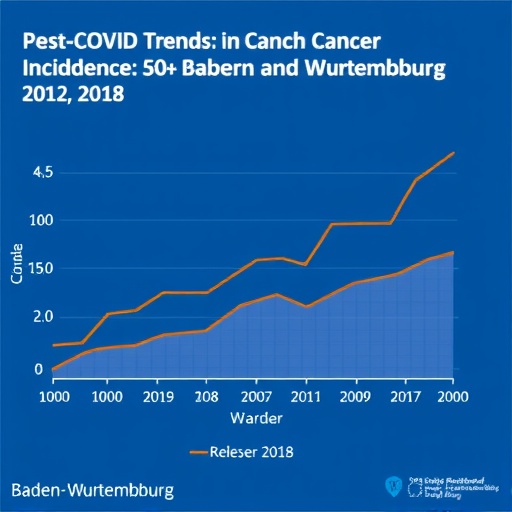Large cell neuroendocrine carcinoma (LCNEC) of the lung remains one of the most enigmatic and formidable malignancies in thoracic oncology. Characterized by its rarity and aggressive clinical behavior, LCNEC presents unique challenges in diagnosis, treatment, and patient management. A groundbreaking study published recently in Nature Communications has significantly advanced our molecular and clinical understanding of this elusive cancer subtype, shedding light on its intricate biology and suggesting novel therapeutic avenues previously unexplored.
Led by Dr. Abdul Rafeh Naqash of the University of Oklahoma, the multi-institutional research effort represents the most comprehensive characterization of LCNEC to date. By integrating extensive molecular profiling with robust clinical outcome data from 590 patients across various health systems in North America and Europe, the researchers were able to delineate the heterogeneity underlying LCNEC tumors. Their findings revealed that LCNEC shares molecular features with both small cell lung cancer (SCLC) and non-small cell lung cancer (NSCLC), two well-studied lung cancer categories, yet also harbors distinct genomic and biological attributes that defy simple classification.
The study’s intricate molecular analyses utilized machine learning algorithms to classify tumors that did not conform neatly to existing categories, highlighting the nuanced intertumoral diversity that has long puzzled clinicians and researchers alike. This stratification is not just academic; it carries profound implications for how LCNEC might be approached therapeutically. Historically, treatment protocols have oscillated between adopting regimens targeted to SCLC or NSCLC, often with limited success. Understanding molecular subtypes could finally enable personalized treatment paradigms tailored specifically to LCNEC’s biology.
.adsslot_IiyTQmR3tr{ width:728px !important; height:90px !important; }
@media (max-width:1199px) { .adsslot_IiyTQmR3tr{ width:468px !important; height:60px !important; } }
@media (max-width:767px) { .adsslot_IiyTQmR3tr{ width:320px !important; height:50px !important; } }
ADVERTISEMENT
A particularly compelling discovery from the research centers on the role of the protein Fibrinogen-like Protein 1 (FGL1). FGL1 has been implicated in immune evasion, assisting tumors in disarming the immune system by inactivating T cells. The team’s identification of FGL1’s involvement in LCNEC biology not only reinforces the tumor’s immune evasive strategies but also illuminates a potential target for immunomodulatory therapy. Currently, drugs exist that inhibit FGL1, thus reactivating immune responses against tumor cells. This offers a promising therapeutic window in a cancer largely refractory to immune checkpoint blockade therapies.
Further compounding the therapeutic challenge, the study documented a marked paucity of cytotoxic T cell infiltration within LCNEC tumors. Tumor-infiltrating lymphocytes, particularly activated T cells, are generally associated with better responses to immunotherapy, but their scarcity in LCNEC suggests an immunosuppressive microenvironment. Clinical data analyzed alongside molecular findings confirmed this hypothesis, showing that patients derived limited benefit from existing immunotherapy approaches, whether as monotherapy or combined with chemotherapy.
While PD-1/PD-L1 checkpoint inhibitors have revolutionized lung cancer treatment broadly, their limited efficacy in LCNEC underscores the urgent need for alternative strategies. The elucidation of FGL1 as a mediator of immune resistance opens a fresh front in this battle, offering hope that targeted disruption of these pathways could restore the immunogenicity of LCNEC tumors. The translational potential of these findings is thus immense, paving the way for forthcoming clinical trials specifically designed to test agents targeting FGL1 and related immunosuppressive mechanisms.
The collaborative synergy between academic investigators and Caris Life Sciences proved essential in achieving such depth of molecular insight. Utilizing Caris’s extensive molecular profiling platform enabled access to diverse genomics and proteomics datasets, permitting a high-resolution dissection of tumor heterogeneity. Such partnerships epitomize the future of oncology research, where integrated clinico-genomic data sets accelerate discovery and therapy optimization, especially for rare cancers that have historically suffered from underfunding and limited research focus.
Dr. Naqash emphasizes the clinical ramifications of the study: recognizing LCNEC as a biologically heterogeneous disease counters the prevailing notion of a “one size fits all” treatment. Instead, this work highlights the complexity embedded in these tumors and advocates for precision oncology approaches that consider genomic and immunological contexts. The call for clinical trials rooted in molecular stratification marks a vital pivot toward more nuanced care for LCNEC patients, who currently face dismal survival outcomes and few standardized treatment options.
This study does more than advance scientific knowledge—it champions the importance of academic research institutions in addressing rare diseases like LCNEC, which often lack the resources and attention afforded to more prevalent cancers. Unraveling the molecular complexity of such diseases is essential for developing effective therapies and ultimately improving patient prognosis. The research sets an example of how multidisciplinary, data-driven investigations can translate to clinical innovation, especially in oncology’s most challenging frontiers.
Moreover, the extensive dataset encompassing nearly 600 patients enhances the study’s robustness and generalizability, allowing researchers to correlate molecular subtypes with survival statistics and treatment responses comprehensively. This integration of genomics with clinical outcomes represents a paradigm shift in understanding LCNEC: no longer viewed solely through histopathologic lenses but as a genetically and immunologically dynamic entity requiring tailored interventions.
The findings also implicate tumor microenvironment dynamics as a critical determinant of therapy responsiveness, underscoring that molecular alterations alone cannot fully predict clinical behavior. Addressing the interplay between cancer cells and immune infiltrates is thus paramount in developing next-generation treatments. Future research will likely expand on these insights, exploring combination therapies that not only target intrinsic tumor pathways such as FGL1 but also modulate the immune landscape to enhance efficacy.
In summation, this seminal work published in Nature Communications provides a pivotal foundation upon which future translational and clinical oncology efforts can build. By illuminating the molecular heterogeneity and immune nuances of large cell neuroendocrine carcinoma, the study offers a beacon of hope for improved diagnostics, prognostication, and most importantly, effective targeted therapies. As clinical trials informed by these findings take shape, the prospects for patients with LCNEC may finally begin to reflect the precision medicine revolution transforming cancer care worldwide.
Subject of Research: People
Article Title: Integrated molecular and clinical characterization of pulmonary large cell neuroendocrine carcinoma
News Publication Date: 19-Aug-2025
Web References:
https://www.nature.com/articles/s41467-025-63091-0
References:
Naqash, A. R., Nassar, A. H., Chiang, A. C., et al. (2025). Integrated molecular and clinical characterization of pulmonary large cell neuroendocrine carcinoma. Nature Communications. DOI: 10.1038/s41467-025-63091-0
Image Credits: University of Oklahoma
Keywords: Lung cancer, Cancer, Lung metastasis, Metastasis, Small cell lung cancer, Activated T cells, Cancer immunotherapy
Tags: advanced cancer research findingsclinical outcomes lung cancerlarge cell neuroendocrine carcinomaLCNEC lung cancermachine learning in oncologymolecular profiling in cancernon-small cell lung cancer featuresnovel therapeutic avenues for lung cancerrare lung cancer typessmall cell lung cancer similaritiesthoracic oncology challengestumor heterogeneity in LCNEC





